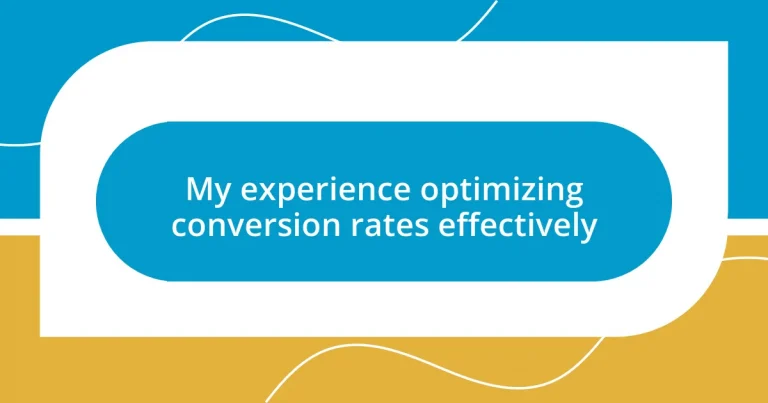Key takeaways:
- Understanding conversion rate optimization (CRO) requires a deep dive into user behavior and leveraging small changes for significant improvements in conversions.
- Key metrics to track for CRO include conversion rate, bounce rate, average session duration, click-through rate, and cart abandonment rate, all of which provide insights into user engagement.
- A/B testing and analyzing customer feedback are essential techniques for refining strategies, leading to informed decisions that enhance user experience and boost conversion rates.
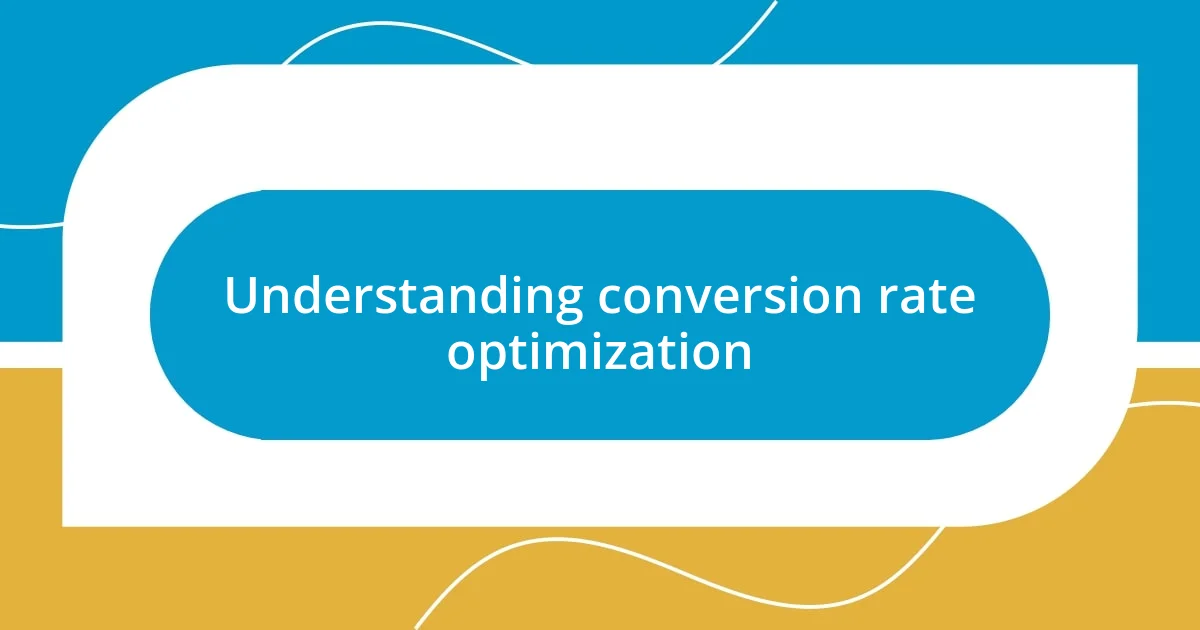
Understanding conversion rate optimization
When I first ventured into the world of digital marketing, conversion rate optimization (CRO) felt like a daunting puzzle. I often asked myself, “What truly drives people to take that final step and make a purchase?” Understanding CRO means delving deep into user behavior and finding the right levers to pull, whether it’s optimizing landing pages or improving call-to-action buttons.
I remember the thrill of running my first A/B test; it was like a light bulb moment. By tweaking headlines and adjusting button colors, I witnessed firsthand how even small changes could lead to significant increases in conversions. This experience taught me that CRO is not just about numbers—it’s about understanding what resonates emotionally with users.
At its core, conversion rate optimization is about connecting with your audience. Have you ever abandoned a cart because the checkout process felt overwhelming? That’s the kind of insight CRO aims to address. By putting myself in the shoes of my customers, I realized the importance of a seamless experience, ultimately turning curious visitors into loyal customers.
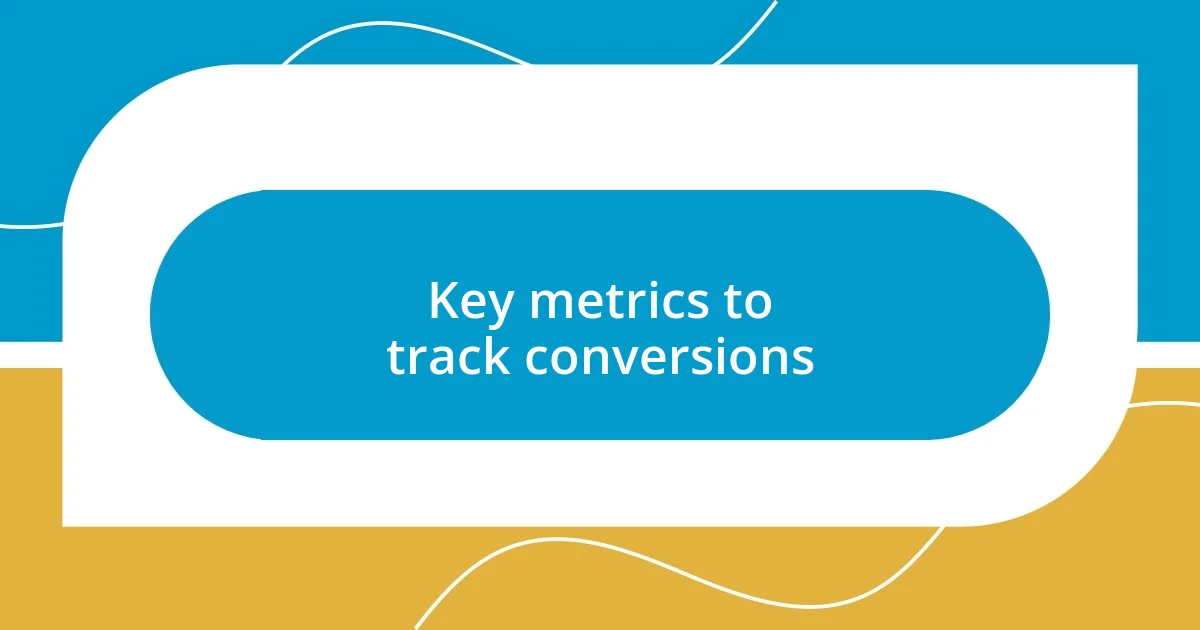
Key metrics to track conversions
Monitoring key metrics is essential for understanding how well your conversion strategies are performing. Over the years, I’ve learned that digging into specific data points can reveal critical insights about user behavior. For instance, I was once surprised to discover that a slight drop in bounce rate correlated with significantly higher conversions. This taught me the value of keeping a close eye on metrics that may not seem directly related to conversions at first glance.
Here are some key metrics I consistently track to optimize conversion rates:
- Conversion Rate: The percentage of visitors who complete a desired action, like making a purchase.
- Bounce Rate: The percentage of visitors that leave after viewing only one page—lowering this can indicate better engagement.
- Average Session Duration: This tells you how long visitors stay on your site and can highlight user interest.
- Click-Through Rate (CTR): The ratio of users who click on a call-to-action to the number of users who view the page—higher rates typically indicate effective messaging.
- Cart Abandonment Rate: Monitoring this helps identify barriers in the checkout process.
Tracking these metrics not only helps refine strategies but also deepens my understanding of what customers value. Just last week, I noticed an uptick in average session duration after I added new content to our product pages, which made me realize that engaging storytelling can significantly impact user investment.
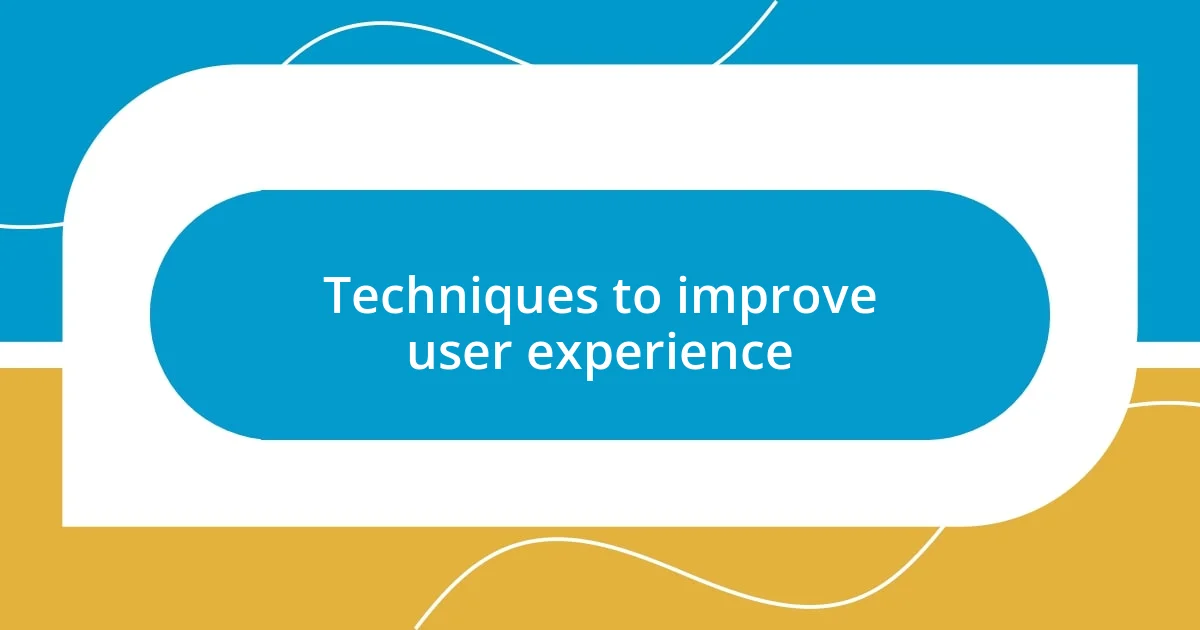
Techniques to improve user experience
To enhance user experience effectively, one technique I’ve found invaluable is simplifying navigation. Imagine visiting a website where you struggle to find what you’re looking for; it’s frustrating! I once redesigned a client’s site based on user feedback, making the menu straightforward and intuitive. The result? Users spent more time exploring, and we saw conversions rise as the streamlined layout made their journey smoother.
Another highly effective approach is optimizing page load speed. I distinctly remember a situation where a slow-loading page caused users to bounce almost immediately. By compressing images and eliminating unnecessary plugins, I improved load times. The improvement was extraordinary—users now stayed longer, and that simple change significantly boosted our conversion rates. It’s remarkable how people appreciate a fast, responsive experience that keeps them engaged.
A/B testing can also uncover what resonates most with users. When I first started experimenting with different color schemes for call-to-action buttons, I was amazed to discover how a simple change—in this case, switching from green to red—increased clicks by over 30%. This taught me that even small adjustments can lead to substantial shifts in user behavior, highlighting the importance of constantly testing and refining elements of the user experience.
| Technique | Description |
|---|---|
| Simplified Navigation | Making navigation straightforward to enhance the user’s journey. |
| Optimized Page Load Speed | Reducing load times to prevent user frustration and increase engagement. |
| A/B Testing | Testing different elements to see which performs better in terms of user engagement. |
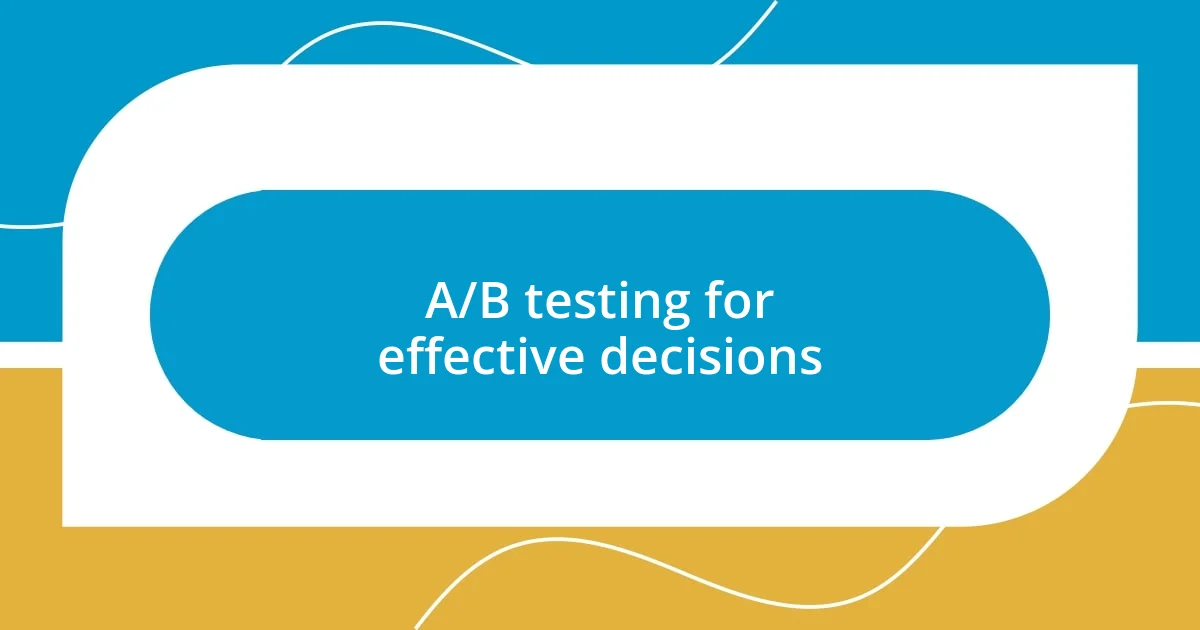
A/B testing for effective decisions
One deeply enlightening experience I had with A/B testing involved the subject line of an email campaign. Initially, I used a straightforward approach that felt safe. But when I decided to test a more playful option, the results were staggering. Not only did the open rates increase by 40%, but the engagement that followed showed me how a simple tweak in tone could resonate far more with my audience than I ever anticipated. Have you ever underestimated the power of a few words?
On another occasion, I was focused on a landing page for a new product. I created two versions: one with an image-heavy layout and another with minimal images and strong text. I was hesitant, thinking the visuals were crucial. To my surprise, the minimalist approach outperformed the other by a notable margin. This taught me that sometimes, less really is more. It prompted me to ask myself—how often do we hold onto preconceived notions that may not reflect our users’ preferences?
Through these experiences, I’ve come to see A/B testing as not just a tool but a dialogue with users. Each test reveals their preferences, guiding me to make informed decisions. It highlights a new level of respect for user input, showcasing that their responses are often the best guide in optimizing conversion rates. It’s empowering to realize that experimenting with small elements can lead to invaluable insights, ultimately driving growth and satisfaction for both the business and its customers.

Analyzing customer feedback for insights
Analyzing customer feedback is one of the most revealing practices I’ve adopted over the years. I remember early on, when I gathered insights through surveys after a product launch, many customers expressed confusion about a particular feature. This pointed observation pushed me to create a more intuitive walkthrough, which not only clarified usage but also fostered a sense of trust among users. How often have you overlooked a subtle hint from your audience that could transform their experience?
Incorporating direct feedback into my strategy transformed my approach to product development. There was a time when my team and I received mixed reviews on the interface of an app. Instead of defending our choices, we dove into the feedback, identifying common pain points. Engaging directly with customers fueled an entire redesign that resonated more deeply with their needs. It felt liberating to shift from assumptions to an evidence-based approach—doesn’t it feel good when users feel heard?
Recently, I saw the power of sentiment analysis firsthand. By using tools to sift through customer comments, I discovered a growing trend where users loved our community features but found the settings too complicated. This was an eye-opener! From there, we not only simplified the settings but also highlighted community engagement in our marketing. It’s astonishing how deeply resolving a simple issue can boost user satisfaction and loyalty, right? This constant dialogue with customers is more than feedback; it’s the roadmap to optimizing conversion rates effectively.
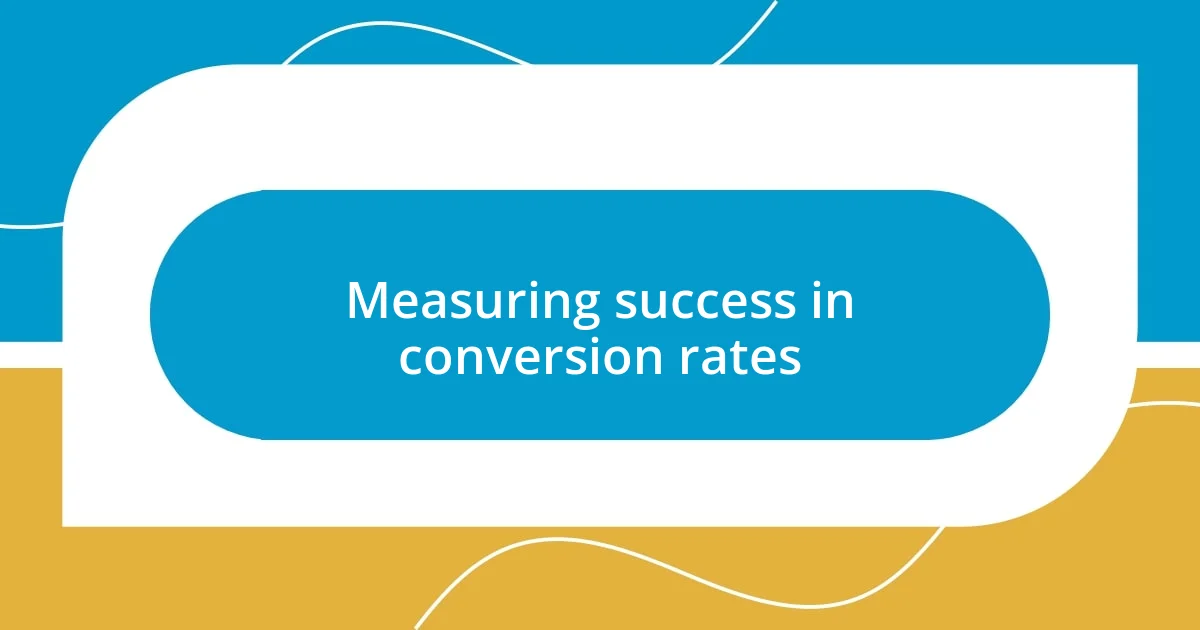
Measuring success in conversion rates
Measuring success in conversion rates can often feel like deciphering a complex puzzle. I remember when I first started tracking these metrics. I fixated on the overall conversion percentage but quickly realized that digging deeper into the data was essential. Using tools like heat maps and user flow analysis opened my eyes to user behavior in ways I hadn’t anticipated. How many hidden patterns lie beneath surface metrics waiting to be uncovered?
One insightful moment came when I compared the performance of different channels driving traffic to my landing page. I noticed that while the paid ads had a respectable conversion rate, organic traffic consistently outperformed it. This revelation reshaped my entire marketing strategy—as I began to prioritize SEO and content marketing, it felt like a game changer. Isn’t it fascinating how understanding the nuances can shift your approach overnight?
Feedback loops also played a crucial role in evaluating success. During monthly reviews, I’d take the time to focus not just on numbers, but on user comments and engagement metrics. One particular comment from a user really struck a chord—it was about how overwhelming they found the checkout process. Addressing this highlighted an actionable area for improvement that directly tied back to conversion rates. Have you ever realized that success isn’t just in the numbers but in the stories behind them? These stories not only reflect data but also illuminate the path for future enhancements.












